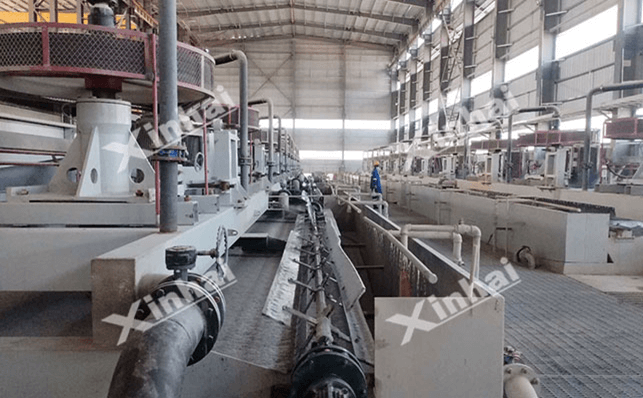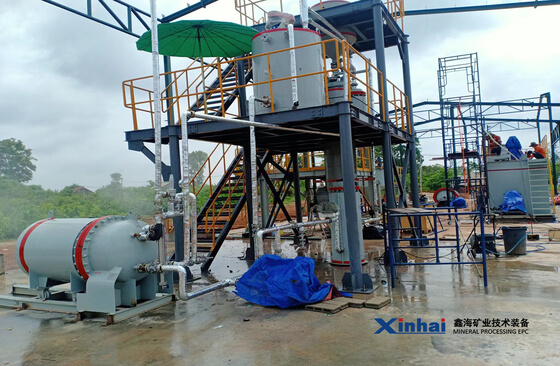
With the development of science and technology, the electronics and new energy industries are developing rapidly, and the consumption and demand of lithium is increasing accordingly. As one of the important lithium resources, spodumene has been widely used in many fields such as nuclear power, electric power generation, metallurgy, high-energy batteries, medicine, glass, ceramics, oil, chemical industry and daily necessities. It is called "the energy to promote world progress" and "the energy of life metal". For the beneficiation of spodumene, this article will introduce six main beneficiation methods for spodumene: manual separation, pre-sliming method, flotation separation, heavy medium separation, magnetic separation and combined beneficiation.
1. Manual Separation for Spodumene Ores
Manual separation can be used as a pre-treatment of spodumene. As a preliminary operation before beneficiation, spodumene and daikite minerals can be manually separated according to color, appearance and luster. According to production practice, the ore size in manual separation is generally within 25-300 mm, and the width is no more than 1200 mm, and the overall speed of the manual separation belt is 0.2-0.4 m/s.
.jpg)
2. Pre-Desliming Method for Spodumene Ores
This method is regarded as a pre-treatment operation for spodumene ore before flotation separation or heavy media separation. A large amount of sludge in the spodumene flotation system leads to poor mineral dispersion, waste of reagents and even increased activation of other daikite minerals, which negatively affects the flotation effect of spodumene. Therefore, before the enrichment operation, it is necessary to separate the sludge from spodumene.
If the spodumene ore contains a large amount of mica, the grinding fineness can be set at -0.074 mm, which is 75%. Dodecylamine or cocoamine is used as a collector of daikite minerals, and sulfuric acid is used to adjust pH = 3, which can effectively improve the sludge environment for subsequent flotation separation of spodumene, as well as significantly increase the content of spodumene concentrate.

3. Flotation Separation of Spodumene Ores
Flotation separation is currently the main separation method in the enrichment of spodumene ores. Common methods include positive flotation separation and reverse flotation separation.
3.1 Positive Flotation Separation for Spodumene Ores
Positive flotation separation of spodumene means that the spodumene ores have been finely ground (avoid over-grinding to cause sedimentation), and then strong alkali is added to the flotation process. In the alkaline medium, after high concentration, strong stirring and repeated washing of the slurry, it is proposed to add oleic acid and its soap salt as a collector to directly float the spodumene, leaving the daikite minerals in the tank. It should be noted that there is no need to add inhibitors in this process.
3.2 Reverse Flotation Separation of Spodumene Ores
In the reverse flotation separation of spodumene ore, lime is used to create an alkaline environment for the ore, while starch, dextrin, etc. are added to suppress the floating of spodumene. Then, cation collectors are added to the slurry to flotate the daikite minerals, so the product in the flotation tank will be spodumene concentrate. If the spodumene contains iron minerals, foaming agents (such as HF resinate) can be added to further remove iron minerals and other impurities.

4. Heavy Media Separation for Spodumene Ores
After the ore is washed and deslimed, the spodumene is mixed with heavy media (the heavy media has two types: heavy liquid and heavy resuspended liquid, here mainly refers to resuspended liquid). Feed the mixture into the heavy media cyclone under the pressure of 0.05~0.20MPa. After processing, the heavy products can be separated from the light products. The heavy product, passing through the separation sieve, turns into spodumene concentrate, and the light one into tailings, the main components of which are daikite minerals - quartz, feldspar and biotite.
5. Magnetic Separation for Spodumene Ores
According to the strength of the mineral's magnetic field, spodumene ore is known as a weakly magnetic mineral. Therefore, in the production sphere, magnetic separation can be used as an auxiliary measure to improve the quality of lithium concentrate. Magnetic separation can be used not only for separating spodumene ores, but also for removing

6. Combined enrichment of spodumene ores
In nature, spodumene is often associated with complex components, so it is quite difficult to obtain qualified lithium concentrate using one enrichment method. If necessary, a combined process can be used to separate spodumene, such as: flotation-magnetic separation combined process, flotation-gravity-magnetic separation combined process, flotation separation-chemical treatment combined process, etc.
There are 6 main methods for beneficiating spodumene. Before putting into production, it is recommended to conduct spodumene beneficiation trials and establish a scientific beneficiation plant based on comprehensive indicators such as ore nature and investment budget, so as to avoid resource loss caused by improper separation methods.
Graphite is an important industrial mineral. With increasing demands for high-purity graphite, the processing of graphite ore is of top priority for the refining and mining industry.
Master titanium ore beneficiation with advanced gravity, magnetic, and electrostatic separation technologies. Learn how leading processors achieve 90%+ recovery rates amid global supply shifts. Xinhai Mining's proven solutions deliver operational excellence.
